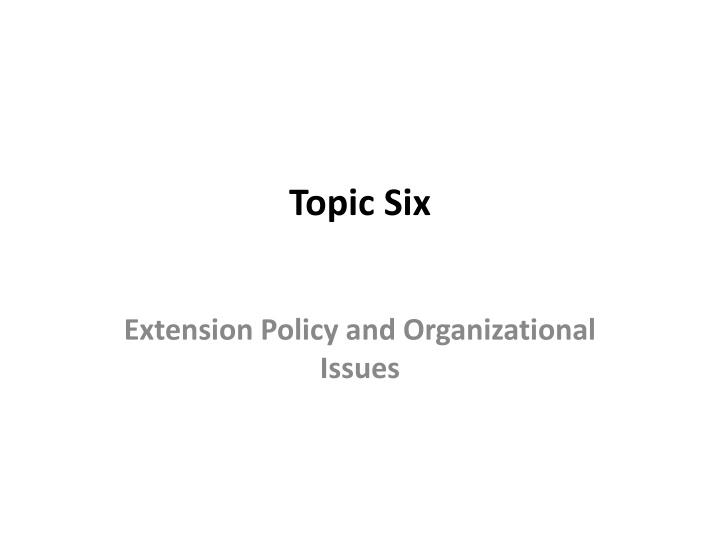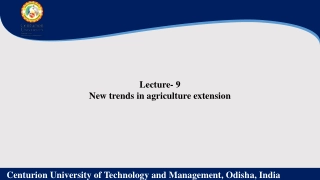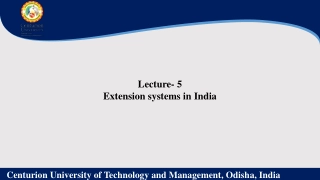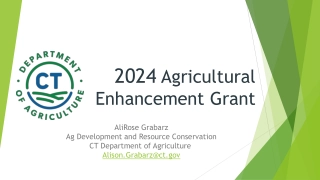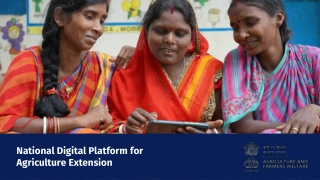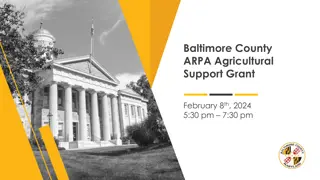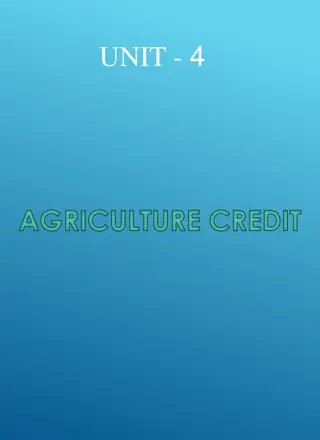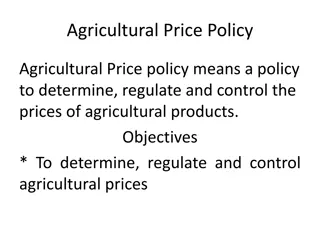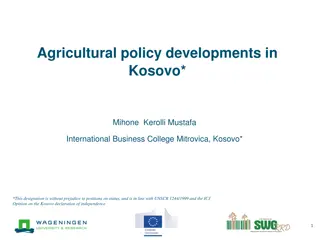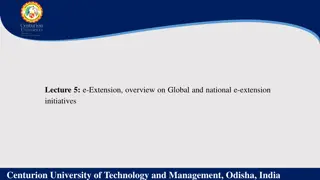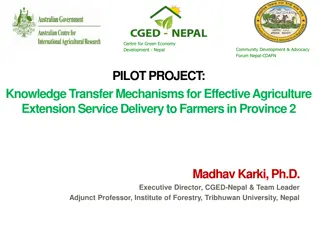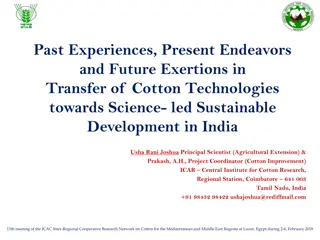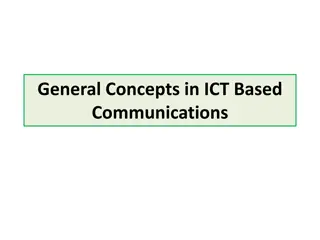Challenges in Formulating Agricultural Extension Policy
Establishing effective agricultural extension services faces challenges due to lack of realistic policies and unstable frameworks. The importance of extension policy is recognized for addressing changing agricultural sector needs and ensuring coordination. Formulating a sound extension policy involves defining mission, clientele, funding, and organizational framework. Addressing population growth, environmental concerns, and agricultural development requires robust policy guidance.
Download Presentation

Please find below an Image/Link to download the presentation.
The content on the website is provided AS IS for your information and personal use only. It may not be sold, licensed, or shared on other websites without obtaining consent from the author.If you encounter any issues during the download, it is possible that the publisher has removed the file from their server.
You are allowed to download the files provided on this website for personal or commercial use, subject to the condition that they are used lawfully. All files are the property of their respective owners.
The content on the website is provided AS IS for your information and personal use only. It may not be sold, licensed, or shared on other websites without obtaining consent from the author.
E N D
Presentation Transcript
Topic Six Extension Policy and Organizational Issues
Formulating extension policy In many countries, the problems of establishing or maintaining an effective agricultural extension service can be due to the lack of a realistic policy or an unstable policy framework for charting the mission of the extension system. The generic problems highlighting issue of extension policy : Lack of agreement on the functions of extension, the clientele to be served, how extension will be financed, frequent changes in organizational structure and programme priorities, rapid turnover of the staff, lack of coordination between different organizations that undertake extension work extension must be responsive to changes in the agricultural sector, the drive toward market reforms, and shrinking government budgets
Ctd. The importance of extension policy was recognized by the FAO's Global Consultation on Agricultural Extension it recommended that "all national governments should develop and periodically review their agricultural extension policy. This policy should include : the goals of agricultural extension, the responsible agencies and personnel the clientele to be served, the broad programmatic areas to be addressed, other relevant guidelines
Ctd Formulating and enacting a sound, comprehensive, and useful extension policy is a difficult undertaking. Lessons from the past can serve as a guide to the future in formulating relevant and useful extension policy in developing countries. Extension policy should include the following: (1) name of the extension system, (2) mission and goals, (3) intended clientele, (4) geographic coverage, (5) the dominant extension approach to be followed, (6) general subject-matter coverage, (7) institutional and organizational framework, (8) how extension will be financed, and (9) provisions for review and accountability within the extension system
Some issues to be considered agricultural and rural development is no longer a matter of just increasing food and agriculture production; other issues (factors) must be addressed by policy makers These issues include population and environmental concerns, climate change they have very strong implications for how key support services such as research and extension should be organized and financed.
Ctd population increases are occurring in developing countries, this implies increase in the demand for food, more pressure on fragile and marginal lands increased land fragmentation larger numbers of landless people in rural areas. These problems point to the need for more education and technical support to farm /pastoral households, both to increase productivity and to preserve natural resources.
ctd Population pressure and the demand for increasing food output are now commonly associated with the degradation, depletion, and pollution of soil, water, and other natural resources. Numerous actions are required for a society to conserve, protect, rehabilitate, and manage its land, water, and other natural resources; therefore, extension has a central role to play in disseminating sustainable agricultural technology.
The Economics of Extension as policy issue Since the 1980s, funding of research and extension has become an increasingly important policy issue, one that has given rise to a progressive decline in financial support for extension. This decline is occurring in a situation where funding of extension has been chronically inadequate. Many economists and development planners believe that public funding of extension should be higher FAO study on this issue involving 114 member countries, showed that in most developing countries government support to extension is generally low when compared to agriculture gross domestic product (about 0.5 per cent of AGDP). The Global Consultation on Agricultural Extension recommended that "in countries where more than 60 % of the economically active population are engaged in agricultural production, approximately 1 to 2 % of the GDP should be considered the minimum level of financial investment to achieve both human resource development and technology transfer goals of a public sector agricultural extension system" .
This erosion in public support for extension may be explained, in part, by several factors, introduction of structural adjustment programmes in many developing countries. the pattern found in industrially developed countries, where research and development (R&D) and technology transfer are predominantly in the hands of the private sector. therefore, the trend has been towards privatizing the extension function with a direct reduction of public funding for extension
This emerging trend is toward a more pluralistic conception of extension, as found in many developing countries today. For policy makers, the implication of this trend would imply the recognition and licensing of both public and private agencies or organizations (including NGOs) to become part of the national agricultural extension system or network. This approach implies the need for public and private sector cooperation to address the twin problems of poor extension coverage and resource limitations.
The Place of Extension Policy in SARD The first principle to recognize is that extension is one of the most strategically important policy instruments for achieving the twin goals of food security and SARD in developing countries. In short, extension policy makers, with the participation of their various stakeholders, need to formulate extension policies that will address both farmers' needs and environmental concerns
Ctd The integration of the food, population, and environmental nexus has led to a new platform of development, Farmers are the single largest group of users and managers of land, water, and other biological resources throughout the world. In 1970, about 790 million people were economically active in agriculture, and this number will increase to around 1.13 billion by the year 2000 and to 1.19 billion by 2010. The majority of these men, women, and young farmers will need useful information, appropriate technology, and sound technical advice not only to increase their agricultural productivity and incomes, but also to make farming and rural life richer and more sustainable.
Scope of extension policy Agricultural extension policy is a part of national development policy in general and of agricultural and rural development policy in particular. Hence, agricultural extension service is one of the policy instruments which governments can use to stimulate agricultural development. Extension is very much a part of what R ling refers to as the agricultural development mix. He notes that extension is a weak instrument when it stands alone, but that it becomes powerful when combined with price incentives, input supply, credit, seed multiplication, and so forth. The Global Consultation on Agricultural Extension concluded that agricultural extension policy should be consistent with and supportive of national agricultural development policy and goals.
Ctd Each country should have a comprehensive agricultural extension policy which provides for coordination with research, education, input supply, and credit and marketing systems, as well as some flexibility to reflect the dynamic nature of the agricultural sector. The policy should include the mission and goals for agricultural extension, the responsible agencies and personnel, the clientele to be served, the broad programmatic areas to be addressed, and other relevant guidelines.
Forms of extension policy More research is needed in classifying extension policies both in developed and developing countries, as well as in those countries in transition. Three forms of extension policies will be discussed Provisional Extension Policies This is the most common form of extension policy in most developing countries. In the absence of more formalized extension policies, or at the time when the formally enacted policy has been suspended, a provisional or ad hoc policy comes into play
Proclamations Declaration and proclamations are policies issued by the head of state or by the executive officer of government. Generally, this approach does not go through the process of consultation and debate involving various stakeholders and beneficiaries. Legislated Extension Policies Extension policies embodied by the country's highest law-making authority (e.g., congress or parliament) are common in many developing countries. Countries that have enacted extension policy through legislative action tend to have well-organized, financially stable extension systems that have sustained effectiveness and a cumulative impact
Examples legislation that established the Cooperative Extension Service in the United States is known as the Smith-Lever Act of May 8, 1914 The Japanese Agricultural Promotion Law of 1948 created and provided funding for Japan's Cooperative Agricultural Extension Service. The same extension policy has guided the Japanese extension system from 1948 to the present Agricultural Extension policy in South Korea today is embodied in the 1957 Agricultural Extension Law and in the Rural Development Law of 1962. Thailand's agricultural extension policy was codified in the 1956 law that created the Department of Agricultural Extension as one of nine departments of the Ministry of Agriculture and Cooperatives.
led the Global Consultation on Agricultural Extension to recommend that "where possible, agricultural extension policy should be formally enacted through legislative action to provide a stable policy foundation, an explicit mandate, and clear direction for developing and executing programmes"
Extension Mission and Goals Although extension has a generic and universal meaning, its mission and goals may need to be adjusted according to national objectives and the context and stage of agricultural and rural development in a given country. The extension mission should be reflected in the name of the organization, This mission then should be reflected in a statement of goals and objectives that are agreed upon and assigned to extension in a supporting policy document. This document should be periodically reviewed by policy makers and representatives from stakeholder groups
Extension Approach and Functions National extension systems can pursue one of several different extension approaches in implementing extension policy. Therefore, the extension approach pursued by a country should reflect the mission of extension, and it will define the functions, programmes, and tasks that will be carried out by the extension staff Subject-Matter Coverage of Extension Broadly speaking, the subject matter of extension is implied in the mission statement and even in the title of the extension service. the subject matter that the extension service will include in its programmes and the target groups to be served among the rural population.
Geographical Coverage some economists believe that agricultural extension should be concentrated in those agricultural areas that are well endowed in terms of both human and natural resources and where the rural infrastructure is already developed. However, to concentrate extension resources on larger, better educated, commercial farmers who frequently control the best land resources in a country will not lead to broad-based agricultural development. Furthermore, the use of only economic criteria in allocating extension resources may result in further degradation of soil and water resources as resource poor farmers continue to exploit marginal land without using appropriate farming practices. Finally, investing in resource poor farm families may increase their technical, management, and leadership skills, thereby enabling them or their children to move into higher paying, nonfarm jobs.
Clientele or Target Beneficiaries A common criticism of extension services in developing countries is their neglect of the vast number of small-scale farmers in favour of fewer numbers of large farmers, or the very limited attention given to women farmers. This is a policy issue because of its implications for the mission and goals of extension, the priorities for technology generation by research, the cost-effectiveness of extension, and the sociopolitical goals of growth with equity and poverty alleviation. The inclusion of women and rural youth in agricultural extension programmes is generally recognized in terms of their numbers and contribution to farming
Organizational Issues The extension organization embodies different aspects of an extension system, and it provides the management framework for the extension service. This is a policy issue because it affects the scope, magnitude, and structure of the extension system, including factors such as control, cost-effectiveness, and the impact of the extension service. 23
Centralized organization. Examples include the Department of Agricultural Extension in Thailand and Bangladesh, the Agricultural Extension Bureau of South Korea, and AGRITEX in Zimbabwe. In this form of organization, the national extension office manages and controls extension programme activities and resources at the regional, district, subdistrict, and village level. Clientele participation and feedback in programme planning are generally limited. Decentralized organization. Examples of this form of extension organization are the agricultural extension systems in Brazil, Canada, India, Nigeria, and the Philippines. These systems have almost an invisible national or federal extension office, in that extension programming, management, and the control of activities and resources are vested with state or provincial governments. 24
Cooperative type of extension organization and funding The distinguishing feature of this form of extension organization is the cooperation or partnership between the national, state or provincial, and local governments in funding, programming, and managing the activities and resources of extension. In the United States, extension is a joint undertaking of the U.S. Department of Agriculture (Federal Extension Service), the state land- grant universities, and the county governments. In Japan, extension is a joint undertaking of the national government and the prefectural government. In China, agricultural extension is a cooperative undertaking of the central, provincial, prefecture, and county governments. Cooperative programming, management, and support are demonstrated at the County Agro-Technical Extension Centre (CATEC), where normally 20 per cent of funding comes from the central government, 30 per cent from the provincial government, and 50 per cent from the county government. 25
Pluralistic forms of a national extension system This is an emerging form of extension organization in many countries, but it is not yet reflected in national extension policy. This structure appears to occur in those countries where the need for extension services is widespread and/or where the public agricultural extension organization can no longer satisfy its clientele because of resource and management problems. As a consequence, many publicly and/or privately funded organizations, including nongovernmental organizations (NGOs), are beginning to conduct agricultural extension programmes. Publicly funded extension organizations may include the crop, livestock, and horticulture departments of the ministry of agriculture, state-funded agricultural colleges and universities, and commodity boards. Privately funded organizations may include rural development-oriented NGOs, agrobusiness firms (contract extension), and farmer organizations, including cooperatives and commodity associations. 26
Extension Staffing Issues By the nature of the mission and work that an extension system carries out, its worth to society is largely reflected by the quality and number of the technical and professional staff in the organization. For a national programme of extension, the human resource question that policy makers and extension managers are confronted with is: Given the mission, scope of the work, and available resources, what type of qualifications and how many extension staff should be employed by the extension system? Part of this staffing matrix inclWhat should be the proportion of subject- matter specialists to field extension workers? What should be the proportion of field extension personnel to the number of farmers, farm households, or other target groups? How should extension staff be deployed, how often should they be transferred, and what incentives should be provided in order to ensure that they work closely with all groups of farmers? udes other questions: 27
Extension Funding The most difficult and challenging policy issue facing extension today is to secure a stable source of funding. With the widespread trend to cut government budgets, including structural adjustment programmes, many policy makers have the impression that public extension is both expensive and a drain on the government's limited resources. At the same time, studies carried out in both developed and developing countries indicate that the returns to extension expenditures are high. Therefore, policy makers should examine this issue carefully in deciding what level of public funding is necessary to support extension in relation to the needs of farmers in the country. While extension managers should look for ways to improve the efficiency and to reduce the cost of public extension and, at the same time policy makers should look for ways to increase extension funding to adequate levels of support. In most developing countries, particularly the low-income, food-deficit countries, absolute levels of extension funding are very low. The Global Consultation on Agricultural Extension noted that "the current level of funding for extension in most developing countries is insufficient to provide adequate coverage for all groups of farmers, especially those who are resource poor and at the subsistence level. 28
Stability A good extension policy promotes extension system stability, yet allows sufficient flexibility to reflect the dynamic nature of the agricultural sector. Extension should not be rigid; rather, "It should be responsive to all major groups of farm people and sufficiently inclusive to allow public, private, and non- governmental organizations to contribute fully to the agricultural development goals of the country". Frequent organizational changes within extension, such as being transferred from one government agency to another, directly impact the organization's effectiveness. Such instability is costly in that trained staff are poorly utilized and opportunities for improved productivity are forgone. Extension policies in some countries have been successful in preventing disruptive and destabilizing change. For more than 80 years, the U.S. has followed, with some flexibility, the 1914 Cooperative Extension Service law. For almost 50 years, Japan has followed its extension policy, and Thailand has successfully followed its extension policy for the past 40 years. In these countries, agricultural extension is recognized as having contributed significantly to increased agricultural productivity and development. 29
Extension policy formulation There is no standard formula to be used in formulating agricultural extension policies. It should be noted, however, that most existing laws and policies on extension have been formulated by planners and policy makers in the ministry of agriculture and agriculture committees in the legislative branch of government. Normally, agricultural extension professionals from agricultural universities or from abroad are called on to provide advice and to assist in drafting extension legislation. A congressional hearing is normally conducted before extension legislation is finally enacted into law. To be more relevant to the needs of farmers and other clientele, extension policy should be reviewed and formulated through a participatory approach. This process could be initiated by dedicated professionals from the public and private sectors, with the active participation of farmers themselves, the private sector, and local government representatives. A proposed draft extension policy that results from this participatory approach would have to be legitimized by the ministry of agriculture and then enacted into law by the congress or parliament. The advantage of this approach would be greater relevance to local conditions and acceptance by stakeholders at the field level. As the Global Consultation on Agricultural Extension noted: "There are sometimes contradictions between national development policy and the interests of the vast majority of the rural poor who are engaged in agricultural production. 30
